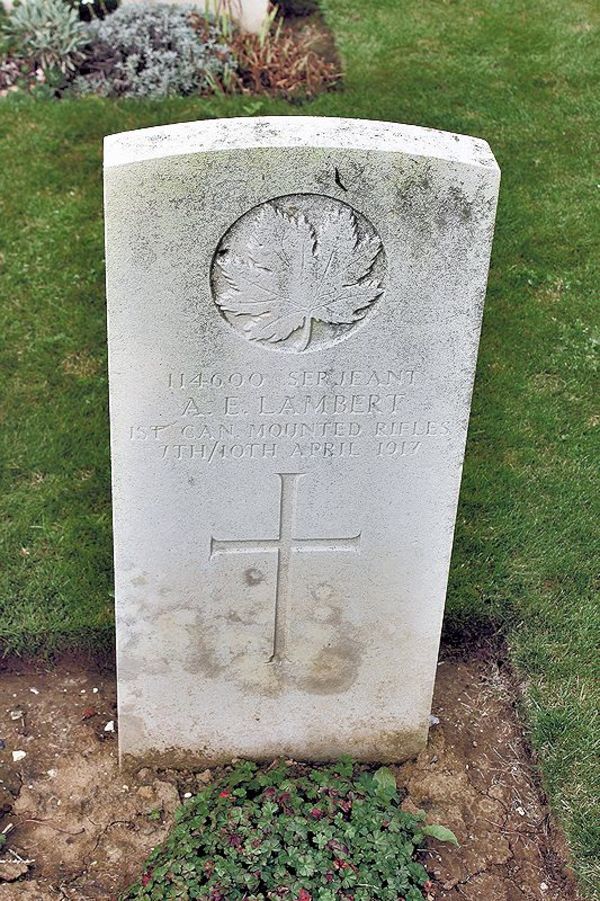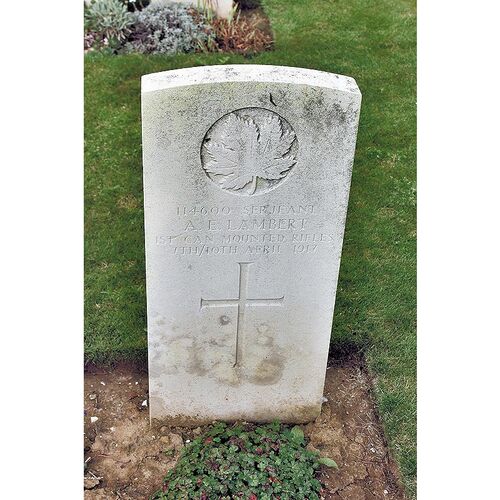
Source: Link
LAMBERT, AUGUSTINE EMMANUEL, settler and soldier; b. 26 Nov. 1894 in London, England, son of George Lambert; d. unmarried 9 or 10 April 1917 near Vimy, France.
Gus Lambert responded to the appeals for young men to seek their fortunes in the Canadian west and arrived at Arelee, Sask., in early May 1913. With his brother Tony, he set up housekeeping nearby and worked for local farmers. He broke the prairie soil with a span of oxen, drove a team of horses during the harvest, and worked on a road-building crew in the summer. A prolific correspondent and an artist of considerable talent, Lambert illustrated his frequent letters home with drawings of his daily activities and so provided a rare visual record of early farming in Saskatchewan.
Lambert had served in the Territorial Army in London, and he was eager to enlist when war broke out in August 1914. He travelled to Saskatoon, the nearest recruiting office, in October only to find all Canadian Expeditionary Force units up to strength and no longer recruiting. But he returned and enlisted in the 9th Canadian Mounted Rifles Regiment on 21 Dec. 1914. Lambert took to soldiering with an easy grace and a standard of dress and deportment which reflected his previous service with the Territorials. He enjoyed the physical demands of riding and hard training, and though he accepted the petty irritations of soldiering with good humour he complained, as most soldiers did, about thoughtless acts which wasted his time or made life needlessly uncomfortable.
In the autumn of 1915 the 9th CMR was still training, and Lambert resigned himself to a winter in tent lines. Suddenly, however, the regiment embarked, and it arrived in Bramshott camp, England, on 8 Dec. 1915. The 9th CMR was soon designated an infantry reinforcement unit, and on 29 Feb. 1916 Lambert was posted to the 1st CMR in France, which formed part of the newly organized 3rd Division [see Malcolm Smith Mercer]. During February and March units of the 3rd Division relieved units of the 1st and 2nd divisions in the salient around Ypres (Ieper), Belgium, to give the inexperienced troops some frontline indoctrination. In late March the 3rd Division took over the sector of the defences which was the easternmost projection of the salient into enemy territory. On 2 June the Germans launched a furious assault, the 1st and 4th CMRs taking the weight of the attack and each suffering more than 75 per cent casualties. Gus Lambert survived this brutal introduction to war and was promoted lance-corporal on 12 June.
The Canadian Corps moved from Ypres to the Somme front in France in early September. Although Ypres had been relatively quiet after the battle of June, the wear and tear of trench warfare had taken its toll and Lambert went out for two weeks with trench fever. He returned to his battalion to be promoted corporal on 23 September and to take part in the attacks on Regina Trench beginning on the 28th, during which he was wounded in the face. Lambert rejoined his unit on 9 October only to return immediately to hospital with influenza. He left hospital late that month to find his battalion had moved to the Arras front. The limited hostilities of the sector included an exchange of trench raids, and on the night of 20 December 400 men of 1st CMR launched a most successful raid. Lambert was promoted sergeant the following day.
Early in 1917 he suffered another bout of influenza but hurried back to his now battle-wise unit to take part in the final preparations for the attack on Vimy Ridge. The 1st CMR stormed up the Vimy slope early on Easter Monday, 9 April, and by 9:00 a.m. was consolidating on its objective, the eastern end of Bois de la Folie, in the centre of the ridge. Before the end of the next day Lambert had been killed. Such was the intensity of the battle that the time and the place of his death were unknown to his surviving comrades.
Gus Lambert represents a special group of Canadians, the host of young immigrants from the United Kingdom who enlisted in the CEF early in the war. Many had previous military service and gave the raw Canadian battalions a leaven of disciplined stability while they learned the grim craft of battle. Canada came of age when the Canadian Corps stormed Vimy Ridge, and thousands of immigrants like Gus Lambert helped carry their adopted country into nationhood.
NA, MG 30, E172 (mfm.); RG 150, Acc. 1992–93/166, file 114600. Nicholson, CEF.
Cite This Article
Jack L. Summers, “LAMBERT, AUGUSTINE EMMANUEL,” in Dictionary of Canadian Biography, vol. 14, University of Toronto/Université Laval, 2003–, accessed December 12, 2025, https://www.biographi.ca/en/bio/lambert_augustine_emmanuel_14E.html.
The citation above shows the format for footnotes and endnotes according to the Chicago manual of style (16th edition). Information to be used in other citation formats:
| Permalink: | https://www.biographi.ca/en/bio/lambert_augustine_emmanuel_14E.html |
| Author of Article: | Jack L. Summers |
| Title of Article: | LAMBERT, AUGUSTINE EMMANUEL |
| Publication Name: | Dictionary of Canadian Biography, vol. 14 |
| Publisher: | University of Toronto/Université Laval |
| Year of publication: | 1998 |
| Year of revision: | 1998 |
| Access Date: | December 12, 2025 |



